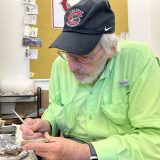Chapman University Researchers Find Big Answers in Little Sea Slugs Sea slugs low brain cell count is revealed in new research.
October 20, 2010
No surprise — sea slugs are not the smartest creatures on the planet. They just don’t have enough brain cells.
But Chapman University researchers were surprised to discover that the little invertebrates apparently are smart enough to remember a nasty lobster attack.
Sea slugs have relatively few brain cells, but what they have are hefty and easily studied under a microscope, serving as a treasure trove for scientists interested in learning and memory. So for decades researchers have zinged sea slugs with mild electric jolts to both observe their behavior – the sea slugs become more defensive and are quicker to withdraw their tender body parts the next time they’re provoked – and examine brain cells that have been changed by the learning process.
But wild sea slugs, or Aplysia californica, don’t face electric predators in nature. Why do they learn better after a zap? What purpose is served by that learning? Is their quick-draw reaction just a sea slug parlor trick induced by researchers? These were the questions asked by William Wright, Ph.D., associate professor, School of Earth and Environmental Sciences, and his student researchers at Chapman University for an aplysia research study that turned up some interesting new information and earned the team publication in the prestigious Journal of Neuroscience. The study was then picked up by Nature, an international journal that publishes news of leading researchers.
Recognition in Nature was a particular honor and surprise, since it followed some time after the first publication and its editors are quite selective about what they choose to highlight, Dr. Wright said.
“I guess I had sort of lost track of how cool the finding is,” Dr. Wright said “There it is, though, right next to articles on astronomy, cancer, and materials science.”
The essence of the results is that sea slugs demonstrate similar learning patterns, or sensitization, when attacked by a hungry lobster as when they are stimulated by electric shocks, proving that there is a real-world use for this behavior so well studied in labs, but unexplored in nature.
Indeed, the research is compelling because it connects to the rising realm of learning and memory studies. (In fact, the sea slug behavior Dr. Wright and his student team put to the test was first used and described by neuroscientist Eric Kandel, for which Kandel won the Nobel Prize.) But while Wright’s project addresses natural history and biomedical issues, it is at its heart basic science. But don’t underestimate basic scientific research, Wright says.
“Basic science is really important. We’re really curious beasts and science is a way of giving that (curiosity) power,” he said. “The ability to change your environment based on past experience is what we do. That’s what culture is. It’s all about learning. So it’s a really cool topic to bring into the natural environment.”
And they haven’t closed the sea slug book. As an outgrowth of the research, Dr. Wright and his students spent time on a Catalina Island marine reserve replicating their lab experiments on wild lobsters and sea slugs, also called sea hares. Those results are expected to be published soon.
Chapman University students involved in the project include Amanda J. Watkins, Daniel A. Goldstein, Lucy C. Lee, Christina J. Pepino, Scott L. Tillett, Francis E. Ross, and Elizabeth M. Wilder.


